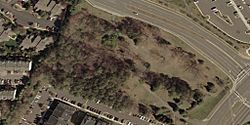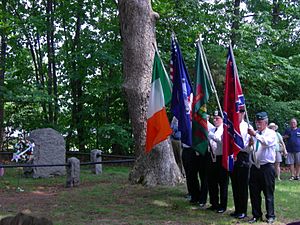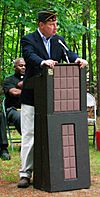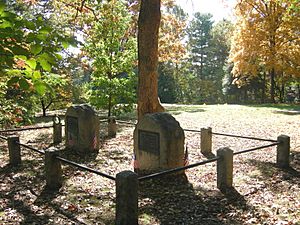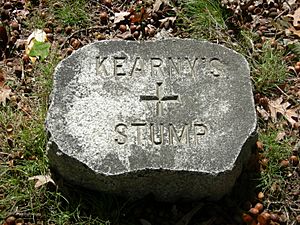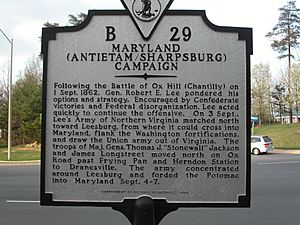Ox Hill Battlefield Park facts for kids
Quick facts for kids Ox Hill Battlefield Park |
|
|---|---|
 |
|
| Location | Fairfax, Fairfax County, Virginia, USA |
| Area | 4.8 acres (0.019 km2) |
| Operated by | Fairfax County Park Authority |
| Status | Open all year |
| Website | Official site: http://www.fairfaxcounty.gov/parks/oxhill/ |
Ox Hill Battlefield Park is a special place in Fairfax, Virginia. It's where an important battle of the American Civil War happened. This battle is known as the Battle of Ox Hill, or sometimes the Battle of Chantilly by the Union soldiers. It was the only big battle of the war fought in Fairfax County.
Today, the battlefield is a public park. It's right next to neighborhoods and a shopping center. The Fairfax County Park Authority takes care of it.
The main things you'll see at the park are two monuments. They honor two Union generals who were killed during the battle: Isaac Stevens and Philip Kearny. General Stevens was killed right in the area of the park. General Kearny died just a little to the west. There are also two Virginia historical markers near the park entrance. They tell about the battle and what happened afterward.
The park is located at 4134 West Ox Road, in Fair Lakes. It's near Route 50, at the corner of West Ox Road and Monument Drive. The park is only about 4.8 acres (0.019 km2) big. This is a very small part of the original battlefield, which was about 300 acres (1.2 km2). Most of the old battlefield now has apartments, offices, and other buildings. But the part that's left is still very important to the battle's history.
Contents
The Battle of Ox Hill
After losing a battle called Second Manassas (or Second Battle of Bull Run to the Union), the Union army moved back to areas near Centreville, Virginia. The Confederate general, Robert E. Lee, wanted to trap the Union army and stop them from getting back to Washington, D.C.. So, he sent 20,000 of his soldiers, led by Stonewall Jackson, to go north and then east. They marched along the Little River Turnpike (which is now part of Route 50) to get behind the Union soldiers.
Union General John Pope found out about this plan. He quickly sent about 6,000 of his own soldiers to stop them.
The two armies met in the afternoon of September 1, 1862. The Confederate soldiers were on Ox Hill, near the Little River Turnpike. The Union soldiers came from the south. A very strong thunderstorm raged as both sides attacked and fought back. Union Generals Stevens and Kearny were both killed during this intense fighting.
During one charge, the 79th New York Highlanders regiment was attacking Confederate soldiers in the woods. General Stevens picked up the regiment's fallen flag and shouted, "Highlanders, my Highlanders, follow your general!" Just seconds later, a Confederate bullet hit his head, and he died right away.
General Kearny was checking out the Union lines after hearing there was a gap. He rode through a cornfield and suddenly came face to face with Confederate soldiers. They shouted, "That's a Yankee officer! Shoot him!" Kearny didn't stop, and shots from the 49th Georgia regiment brought him down.
By the time night came, neither side had won completely, and both armies pulled back. The Union army lost about 1,300 soldiers (killed or wounded). The Confederacy lost about 800.
The main part of the Union army was able to retreat further east towards Washington. This stopped General Lee from fully defeating the Union army and protected the capital city. But it cost many lives and two important generals. Lee then turned his army towards Maryland. Sixteen days later, they fought the Battle of Antietam.
History of the Park
A Confederate soldier named John N. Ballard, who lost a leg in the war, ended up owning much of the Ox Hill battlefield in the 1870s. In 1915, Ballard and his wife gave a small piece of land near where General Stevens died. They wanted this land to be a place where people could put up monuments to remember any Confederate or Union soldier who died in the battle.
This land was given to six people (called trustees) who would take care of it. Three were from New Jersey (General Kearny's home state) and three were from Virginia. The monuments for Stevens and Kearny were officially opened on October 2, 1915.
In the 1980s, the area around the battlefield started to be built up with businesses and homes. The company that bought the land where the monuments were wanted to move them. But many people didn't like this idea, and there were articles in The Washington Post. So, in 1987, the company agreed to leave the monuments where they were. They also gave about 2.4 acres (9,700 m2) of land around the monuments to Fairfax County. In 1994, the county bought another 2.4 acres (9,700 m2). The rest of the battlefield is now completely developed.
For many years, there were just signs for Ox Hill Battlefield Park, but not much else was done. In 2004, the Fairfax County Park Authority made plans to make the park better. These plans included restoring some parts of the Civil War battlefield, adding two new monuments for Confederate and Union soldiers, and putting up more signs. These plans were approved in 2005.
The Fairfax County Park Authority officially opened the newly improved park on September 1, 2008. This was 146 years after the battle. The new park has a trail that's easy for wheelchairs, signs and displays that explain things, and three six-sided information stands. Visitors can also step into a part of the original cornfield, which has reconstructed fences like the ones from the battle. The cornfield is planted with grasses that look like corn, because real corn would be too much work to take care of.
Events at the Park
About two or three times a year, groups gather at the park for special events. These events remember the battle or act out parts of history. They usually happen around important dates like Memorial Day, September 1st (the battle's anniversary), and Veterans Day.
On Memorial Day, a group called the Ancient Order of Hibernians often holds a ceremony. They place wreaths and have Civil War re-enactors (people who dress up and act like soldiers from the past) perform a color guard with flags.
For several years, a group called the 28th Massachusetts Volunteer Infantry, Company B, held a special event near September 1st. This included people dressed up and acting like people from the past, talks by local historians, and demonstrations of what soldiers did and how they treated injuries. They also showed tents, gear, and how soldiers cooked.
Park Features
Kearny and Stevens Memorial
The memorial for Generals Kearny and Stevens includes two granite monuments. They are surrounded by an iron fence with granite posts. Each monument has the general's name carved on one side. The other side has a plaque honoring them. These monuments are not gravestones, but are cenotaphs. This means they are memorials, but the generals are buried somewhere else.
Neither general died exactly where their monument is. Stevens was killed nearby, and Kearny died about 150 yards (140 m) southwest of the park. The small piece of land with the memorial is not officially part of the park. It's still owned by its trustees. But the park probably wouldn't exist today without these monuments. The plaques on the monuments say:
| Stevens | Kearny |
|---|---|
|
Here Fell |
Major General |
Note: Stevens was a brigadier general when he died. He was later given the higher rank of major general after his death.
Stone Markers
Kearny's Stump is a granite marker shaped like a tree stump. It's a few feet away from the main memorial. People used to think the original tree stump was the exact spot where Kearny was killed. However, we now know he died in a cornfield about 150 yards (140 m) away, outside the park's current boundaries. The original stump was used to mark the memorial plot. When it rotted away, it was replaced with this stone version.
There is also a pile of fieldstone rocks and a quartzite boulder in the park. People believe this marks the spot where General Stevens was killed.
As of September 2008, the Fairfax County Park Authority planned to raise money to build two large granite monuments. These would honor the regular soldiers who fought in the battle, because only the two Union officers are currently remembered. One monument would be for the Union soldiers and called "Chantilly." The other would be for the Confederate soldiers and called "Ox Hill."
Signs and Information
In 2000, two Virginia Historical Markers were placed at the park entrance. Marker B-13, called Battle of Ox Hill (Chantilly), tells about the battle itself. Marker B-29, called Maryland (Antietam/Sharpsburg) Campaign, talks about the start of General Lee's Maryland Campaign. This campaign included the Battle of Antietam. Nearby, there is also a sign that gives a short description of the battle.
In 2008, the Fairfax County Park Authority put up three six-sided information stands. These stands tell the story of the battle and why it was important in the war in Virginia. The information stands are designed with colors from the war: gray sides (for the Confederates) and blue roofs (for the Union).



